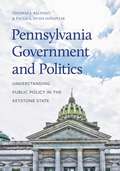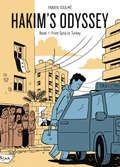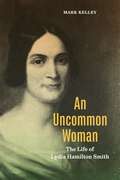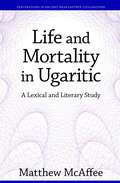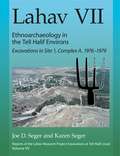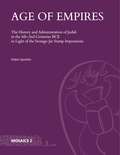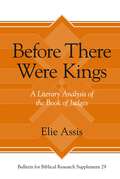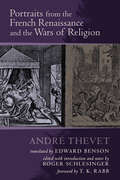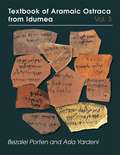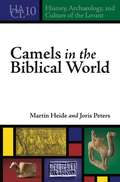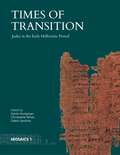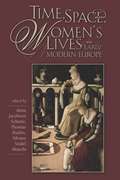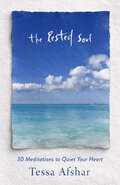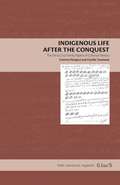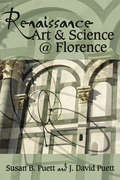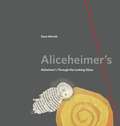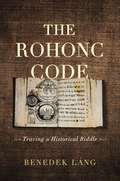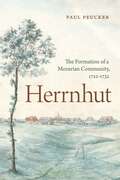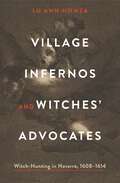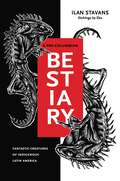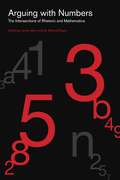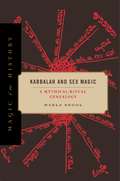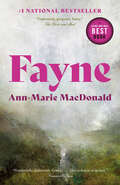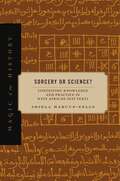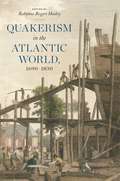- Table View
- List View
Pennsylvania Government and Politics: Understanding Public Policy in the Keystone State (Keystone Books)
by Thomas J. Baldino Paula A. Duda HoloviakThis book provides a comprehensive examination of the Keystone State’s formal and informal political institutions and players, past and present, and elucidates the place each holds in governing the commonwealth today. Covering a period of more than three hundred years, this volume presents a clear and succinct overview of• the commonwealth’s political history, culture, and geography;• interactions between office holders, civil servants, special interest groups, and the media;• policy development and implementation;• how laws are created, enacted, and enforced;• hierarchy and interaction among state, county, local, and special district government bodies and officials;• tax collection and disbursement; and• the political upheaval in the wake of the COVID-19 pandemic and the 2020 presidential election.Featuring practical appendixes and interviews with current and past office holders, bureaucrats, party leaders, and political journalists, this astute and informative book is an indispensable tool for understanding politics in the Keystone State.
Hakim’s Odyssey: Book 1: From Syria to Turkey
by Fabien ToulméA remarkable recounting of a human journey through an inhumane world.What does it mean to be a “refugee”? It is easy for those who live in relative freedom to ignore or even to villainize people who have been forced to flee their homes. After all, it can be hard to identify with others’ experiences when you haven’t been in their shoes.In Hakim’s Odyssey, we see firsthand how war can make anyone a refugee. Hakim, a successful young Syrian who had his whole life ahead of him, tells his story: how war forced him to leave everything behind, including his family, his friends, his home, and his business. After the Syrian uprising in 2011, Hakim was arrested and tortured, his town was bombed, his business was seized by the army, and members of his family were arrested or disappeared. This first leg of his odyssey follows Hakim as he travels from Syria to Lebanon, Lebanon to Jordan, and Jordan to Turkey, where he struggles to earn a living and dreams of one day returning to his home.This graphic novel is necessary reading for our time. Alternately hopeful and heartbreaking, Hakim’s Odyssey is a story about what it means to be human in a world that sometimes fails to be humane.
An Uncommon Woman: The Life of Lydia Hamilton Smith (Keystone Books)
by Mark KelleyLydia Hamilton Smith (1813–1884) was a prominent African American businesswoman in Lancaster, Pennsylvania, and the longtime housekeeper, life companion, and collaborator of the state’s abolitionist congressman Thaddeus Stevens. In his biography of this remarkable woman, Mark Kelley reveals how Smith served the cause of abolition, managed Stevens’s household, acquired property, and crossed racialized social boundaries.Born a free woman near Gettysburg, Smith began working for Stevens in 1844. Her relationship with Stevens fascinated and infuriated many, and it made Smith a highly recognizable figure both locally and nationally. The two walked side by side in Lancaster and in Washington, DC, as they worked to secure the rights of African Americans, sheltered people on the Underground Railroad, managed two households, raised her sons and his nephews, and built a real-estate business. In the last years of Stevens’s life, as his declining health threatened to short-circuit his work, Smith risked her own well-being to keep him alive while he led the drive to end slavery, impeach Andrew Johnson, and push for the ratification of the Thirteenth, Fourteenth, and Fifteenth Amendments.An Uncommon Woman is a vital history that accords Lydia Hamilton Smith the recognition that she deserves. Every American should know Smith’s inspiring story.
Life and Mortality in Ugaritic: A Lexical and Literary Study (Explorations in Ancient Near Eastern Civilizations)
by Matthew McAffeeWhile topics such as death, funerary cult, and the netherworld have received considerable scholarly attention in the context of the Ugaritic textual corpus, the related concept of life has been relatively neglected. Life and Mortality in Ugaritic takes as its premise that one cannot grasp the significance of mwt (“to die”) without first having wrestled with the concept of ḥyy (“to live”). In this book, Matthew McAffee takes a lexical approach to the study of life and death in the Ugaritic textual corpus. He identifies and analyzes the Ugaritic terms most commonly used to talk about life and mortality in order to construct a more representative framework of the ancient perspective on these topics, and he concludes by synthesizing the results of this lexical study into a broader literary discussion that considers, among other things, the implications for our understanding of the first-millennium Katumuwa stele from Zincirli.McAffee’s study complements previous scholarly work in this area, which has tended to rely on conceptual and theoretical treatment of mortality, and advances the discussion by providing a more focused lexical analysis of the Ugaritic terms in question. It will be of interest to Semitic scholars and those who study Ugaritic in particular, in addition to students of the culture of the ancient Levant.
Lahav VII: Excavations in Site 1, Complex A, 1976–1979 (Lahav: Reports of the Lahav Research Project / Excavations at Tell Halif, Israel)
by Joe D. Seger Karen SegerThis seventh volume of final reports of the Lahav Research Project’s efforts at Tell Halif in Southern Israel focuses on the team’s excavations and related regional ethnographic research at adjacent Khirbet Khuweilifeh, an early twentieth-century settlement of Bedouin and Arab fellahin clients. These efforts illustrate the symbiosis between the itinerant Bedouin and their seasonal sharecropper neighbors along the northern flanks of the Negev desert during and following the First World War in southern Palestine.The stratigraphic excavation and recovery of material culture from Cave Complex A revealed a pattern of occupation dating from the late nineteenth century C.E. up to the mid-1940s and produced hundreds of artifacts and samples, giving testimony to the lifeways of the fellahin who had inhabited the complex. The associated ethnographic research with Bedouin sheikhs and Hebron-area merchant informants established that the Complex’s most recent occupants were the family of a plow maker named Khalil al-Kaayke. The studies elucidated in this volume articulate in more detail the family’s patterns of subsistence, showing the interdependence of the Bedouin and fellahin partners. Examination of the pottery remains provides a profile of the site’s Stratum I, early twentieth-century ceramic forms and also reveals earlier Islamic-period and pre-Islamic traces.Over the past century the lifeways of these early twentieth-century Bedouin and their fellahin village neighbors in southern Palestine have been rapidly disappearing. This volume serves to chronicle and preserve data on their waning history and culture.
Age of Empires: The History and Administration of Judah in the 8th–2nd Centuries BCE in Light of the Storage-Jar Stamp Impressions (Mosaics: Studies on Ancient Israel #2)
by Oded LipschitsStorage jars of many shapes and sizes were in widespread use in the ancient world, transporting and storing agricultural products such as wine and oil, crucial to agriculture, economy, trade and subsistence. From the late 8th to the 2nd century BCE, the oval storage jars typical of Judah were often stamped or otherwise marked: in the late 8th and early 7th century BCE with lmlk stamp impressions, later in the 7th century with concentric circle incisions or rosette stamp impressions, in the 6th century, after the fall of Jerusalem, with lion stamp impressions, and in the Persian, Ptolemaic and Seleucid periods (late 6th–late 2nd centuries BCE) with yhwd stamp impressions. At the same time, several ad hoc systems of stamp impressions appeared: "private" stamp impressions were used on the eve of Sennacherib’s campaign, mwṣh stamp impressions after the destruction of Jerusalem, and yršlm impressions after the establishment of the Hasmonean state. While administrative systems that stamped storage jars are known elsewhere in the ancient Near East, the phenomenon in Judah is unparalleled in its scale, variety and continuity, spanning a period of some 600 years without interruption.This is the first attempt to consider the phenomenon as a whole and to develop a unified theory that would explain the function of these stamp impressions and shed new light on the history of Judah during six centuries of subjugation to the empires that ruled the region—as a vassal kingdom in the age of the Assyrian, Egyptian, and Babylonian empires and as a province under successive Babylonian, Persian, Ptolemaic, and Seleucid rule.
Before There Were Kings: A Literary Analysis of the Book of Judges (Bulletin for Biblical Research Supplement)
by Elie AssisFollowing the great periods of national leadership by Moses and Joshua, the book of Judges depicts the stewardship of various judges that rose to power to solve local religious and military challenges in the premonarchic period. This volume provides a close reading of the entire book of Judges, taking seriously the distinct elements of the book and how they are interconnected.Elie Assis explores the ways in which the ideology and theology of Judges unfold through a careful literary analysis. Moving beyond the cycle of sin, punishment, and salvation, Assis demonstrates how differences in the descriptive language applied to each judge, as well as the evaluations in the opening and concluding chapters, provide clues as to the organization and message of the text. Most works on Judges focus on the historical background of the period or the historical process of the book’s composition and seek to dissolve its stories into component parts. In contrast, Before There Were Kings points to the deep underlying unity of Judges and the function of the individual stories within the whole.New and carefully drawn insights related to the purpose of each section and the themes that shape the book as a whole make this a groundbreaking, programmatic contribution to research on the book of Judges. It will be of particular interest to students and scholars of the Old Testament and the Hebrew Bible.
Portraits from the French Renaissance and the Wars of Religion (Early Modern Studies)
by André ThevetAvailable for the first time in English, these thirteen selections from André Thevet’s Les vrais pourtraits et vies des hommes illustres offer a glimpse of France during a time of great upheaval. Originally published in 1584, Thevet’s collection contains over two hundred biographical sketches, detailing the lives of important persons from antiquity to the sixteenth century. Edward Benson and Roger Schlesinger have translated and annotated Thevet’s portraits of his contemporaries, and divided them into three categories: monarchs, aristocrats, and scholars. Additionally, an extensive introduction places the work in context and describes the critical attention that Thevet and his writings have received. Together these portraits provide a history of sixteenth-century France as the country underwent tremendous change: from an intellectual renaissance and its first encounter with the New World to the Protestant Reformation and the Wars of Religion that followed. France was irrevocably altered by these events and Thevet’s account of the lives of individuals who struggled with them is indispensable.
Textbook of Aramaic Ostraca from Idumea, Volume 3: 401 Commodity Chits
by Bezalel Porten Ada YardeniSince the early 1990s, about two thousand Idumean Aramaic ostraca have found their way into museums, libraries, and private collections. Four major publications covering some of these texts have appeared, three of which encompass the ostraca held by individual collectors only. This multivolume work classifies the ostraca according to subject matter and brings them together in a single publication. Volumes 1 and 2 covered fifty personal name dossiers (TAO A1-50). Volume 3 contains more than two hundred more such dossiers (TAO A51-255a) and numerous fragments. Each text is accompanied by a color photograph and hand-copy, a facing transcription and translation, and a ceramic description and commentary. The translation uniquely provides marginal captions identifying the phrases. In addition to the presentation of individual texts, there are six dossiers of tables covering all the commodity chits, parallel tables that classify them according to month or size, and comparative lists of entries.Textbook of Aramaic Ostraca from Idumea is a unique source for the onomastics and the social and economic history of fourth-century Idumea and, by extension, Judah (Yehud).
Camels in the Biblical World (History, Archaeology, and Culture of the Levant)
by Martin Heide Joris PetersCamels are first mentioned in the Bible as the movable property of Abraham. During the early monarchy, they feature prominently as long-distance mounts for the Queen of Sheba, and almost a millennium later, the Gospels tell us about the impossibility of a camel passing through a needle’s eye. Given the limited extrabiblical evidence for camels before circa 1000 BCE, a thorough investigation of the spatio-temporal history of the camel in the ancient Near and Middle East is necessary to understand their early appearance in the Hebrew Bible.Camels in the Biblical World is a two-part study that charts the cultural trajectories of two domestic species—the two-humped or Bactrian camel (Camelus bactrianus) and the one-humped or Arabian camel (Camelus dromedarius)—from the fourth through first millennium BCE and up to the first century CE. Drawing on archaeological camel remains, iconography, inscriptions, and other text sources, the first part reappraises the published data on the species’ domestication and early exploitation in their respective regions of origin. The second part takes a critical look at the various references to camels in the Hebrew Bible and the Gospels, providing a detailed philological analysis of each text and referring to archaeological data and zoological observations whenever appropriate. A state-of-the-art evaluation of the cultural history of the camel and its role in the biblical world, this volume brings the humanities into dialogue with the natural sciences. The novel insights here serve scholars in disciplines as diverse as biblical studies, (zoo)archaeology, history, and philology.
Times of Transition: Judea in the Early Hellenistic Period (Mosaics: Studies on Ancient Israel #1)
by Sylvie honigman, Christophe Nihan and Oded LipschitsThis multidisciplinary study takes a fresh look at Judean history and biblical literature in the late fourth and third centuries BCE. In a major reappraisal of this era, the contributions to this volume depict it as one in which critical changes took place.Until recently, the period from Alexander’s conquest in 332 BCE to the early years of Seleucid domination following Antiochus III’s conquest in 198 BCE was reputed to be poorly documented in material evidence and textual production, buttressing the view that the era from late Persian to Hasmonean times was one of seamless continuity. Biblical scholars believed that no literary activity belonged to the Hellenistic age, and archaeologists were unable to refine their understanding because of a lack of secure chronological markers. However, recent studies are revealing this period as one of major social changes and intense literary activity. Historians have shed new light on the nature of the Hellenistic empires and the relationship between the central power and local entities in ancient imperial settings, and the redating of several biblical texts to the third century BCE challenges the traditional periodization of Judean history.Bringing together Hellenistic history, the archaeology of Judea, and biblical studies, this volume appraises the early Hellenistic period anew as a time of great transition and change and situates Judea within its broader regional and transregional imperial contexts.
Time, Space, and Women’s Lives in Early Modern Europe (Sixteenth Century Essays & Studies #57)
by Anne Jacobson SchutteThis collection offers a variety of approaches to aspects of women’s lives. It moves beyond men’s prescriptive pronouncements about female nature to women's lived experiences, replacing the singular woman with plural women and illuminating female agency. The contributors show that women’s lives changed over the life course and differed according to region and social class. They also demonstrate that in the early modern period the largely private spaces in women’s lives were not enclosed worlds isolated from the public spaces in which men operated.Contributors to this important collection are leading international scholars and offer strong, substantial, and archival-based research.
The Rested Soul: 30 Meditations to Quiet Your Heart
by Tessa AfsharTrue shalom for an anxiety-ridden world. Do you feel rested and at peace? Or are you bombarded with obstacles keeping you from true soul rest? Daily life can be a grind, full of confusion and chaos. Award-winning author and Bible teacher Tessa Afshar has been there. Drawing from the lessons she learned from battling anxiety in her own life, Tessa brings you on a journey that cultivates a rested soul. A book of 30 devotionals, The Rested Soul, includes vulnerable stories from Tessa&’s personal life—stories that will make you feel known and remind you that you are not alone. Full of inspiration found in ordinary moments, Tessa shows you how to remove the impediments that stand in the way of a quiet heart. These deep reflections are accompanied by beautiful images (photography by Tessa&’s husband). Exhale, heal, and find rest in God. Tessa&’s meditations create an oasis of calm when powerful storms of anxiety assail you. She brings you into your hope-filled, joy-infused life in Jesus. In Him, our hearts find quiet and comfort. In Him, we have favor, authority, and strength. In Jesus, we find The Rested Soul.
Indigenous Life After the Conquest: The De la Cruz Family Papers of Colonial Mexico (Latin American Originals)
by Caterina Pizzigoni Camilla TownsendThis book presents a unique set of written records belonging to the De la Cruz family, caciques of Tepemaxalco in the Toluca Valley. Composed in Nahuatl and Spanish and available here both in the original languages and in English translation, this collection of documents opens a window onto the life of a family from colonial Mexico’s indigenous elite and sheds light on the broader indigenous world within the Spanish colonial system.The main text is a record created in 1647 by long-serving governor don Pedro de la Cruz and continued by his heirs through the nineteenth century, along with two wills and several other notable documents. These sources document a community history, illuminating broader issues centering on politics, religion, and economics as well as providing unusual insight into the concerns and values of indigenous leaders. These texts detail the projects financed by the De la Cruz family, how they talked about them, and which belongings they deemed important enough to pass along after their death. Designed for classroom use, this clear and concise primary source includes a wealth of details about indigenous everyday life and preserves and makes accessible a rich and precious heritage. The engaging introduction highlights issues of class relations and the public and performative character of Nahua Christianity. The authors provide the necessary tools to help students understand the colonial context in which these documents were produced.
Renaissance Art & Science @ Florence (Early Modern Studies #17)
by Susan B. Puett J. David PuettThe creativity of the human mind was brilliantly displayed during the Florentine Renaissance when artists, mathematicians, astronomers, apothecaries, architects, and others embraced the interconnectedness of their disciplines. Artists used mathematical perspective in painting and scientific techniques to create new materials; hospitals used art to invigorate the soul; apothecaries prepared and dispensed, often from the same plants, both medicinals for patients and pigments for painters; utilitarian glassware and maps became objects to be admired for their beauty; art enhanced depictions of scientific observations; and innovations in construction made buildings canvases for artistic grandeur. An exploration of these and other intersections of art and science deepens our appreciation of the magnificent contributions of the extraordinary Florentines.
Aliceheimer’s: Alzheimer’s Through the Looking Glass (Graphic Medicine)
by Dana Walrath“Alice was always beautiful—Armenian immigrant beautiful, with thick, curly black hair, olive skin, and big dark eyes,” writes Dana Walrath. Alice also has Alzheimer’s, and while she can remember all the songs from The Music Man, she can no longer attend to the basics of caring for herself. Alice moves to live with her daughter, Dana, in Vermont, and the story begins. Aliceheimer’s is a series of illustrated vignettes, daily glimpses into their world with Alzheimer’s. Walrath’s time with her mother was marked by humor and clarity: “With a community of help that included pirates, good neighbors, a cast of characters from space-time travel, and my dead father hovering in the branches of the maple trees that surround our Vermont farmhouse, Aliceheimer’s let us write our own story daily—a story that, in turn, helps rewrite the dominant medical narrative of aging.” In drawing Alice, Walrath literally enrobes her with cut-up pages from Alice’s Adventures in Wonderland. She weaves elements from Lewis Carroll’s classic throughout her text, using evocative phrases from the novel to introduce the vignettes, such as “Disappearing Alice,” “Missing Pieces,” “Falling Slowly,” “Curiouser and Curiouser,” and “A Mad Tea Party.” Walrath writes that creating this book allowed her not only to process her grief over her mother’s dementia, but also “to remember the magic laughter of that time.” Graphic medicine, she writes, “lets us better understand those who are hurting, feel their stories, and redraw and renegotiate those social boundaries. Most of all, it gives us a way to heal and to fly over the world as Alice does.” In the end, Aliceheimer’s is indeed strangely and utterly uplifting.
The Rohonc Code: Tracing a Historical Riddle
by Benedek LángFirst discovered in a Hungarian library in 1838, the Rohonc Codex keeps privileged company with some of the most famous unsolved writing systems in the world, notably the Voynich manuscript, the Phaistos Disk, and Linear A. Written entirely in cipher, this 400-year-old, 450-page-long, richly illustrated manuscript initially gained considerable attention but was later dismissed as an apparent forgery. No serious scholar would study it again until the turn of the twenty-first century. This engaging narrative follows historian Benedek Láng’s search to uncover the truth about this thoroughly mysterious book that has puzzled dozens of codebreakers. Láng surveys the fascinating theories associated with the Codex and discusses possible interpretations of the manuscript as a biblical commentary, an apocryphal gospel, or a secret book written for and by a sect. He provides an overview of the secret writing systems known in early modern times and an account of the numerous efforts to create an artificial language or to find a long-lost perfect tongue—endeavors that were especially popular at the time the Codex was made. Lastly, he tests several codebreaking methods in order to decipher the Codex, finally pointing to a possible solution to the enigma of its content and language system.Engagingly written, academically grounded, and thoroughly compelling, The Rohonc Code will appeal to historians, scholars, and lay readers interested in mysteries, codes, and ciphers.
Herrnhut: The Formation of a Moravian Community, 1722–1732 (Pietist, Moravian, and Anabaptist Studies)
by Paul PeuckerIn June 1722, three families from Moravia settled on the estate of Count Nikolaus Ludwig von Zinzendorf in Berthelsdorf, Saxony. Known as the community of Herrnhut, their settlement quickly grew to become the epicenter of a transatlantic religious movement, one that would attract thousands of Europeans, American Indians, and enslaved Africans: the Moravian Church.Written by one of the leading archivists of the Moravian Church, this book investigates the origins of Herrnhut. Paul Peucker argues that Herrnhut was intended to be a Philadelphian community, uniting “true Christians” from all denominations. It was a separatist movement, but it concealed its separatism behind the pretense of an affiliation with the Lutheran Church and behind a chosen historical identity, that of the renewed Unity of Brethren. Peucker’s analysis, based on hundreds of documents from archives in Germany and the United States, demonstrates how Herrnhut was able to grow and thrive despite existing regulations against new religious groups, uncovers Count Zinzendorf’s role in keeping Herrnhut outside the state church, and provides a new foundation from which to interpret the Moravian church’s later years.Three centuries after Herrnhut’s founding, this intriguing history brings to light new information about the early years of the Moravian church. Peucker’s work will be especially valuable to students and scholars of eighteenth-century religion, Pietism, and Moravian history.
Village Infernos and Witches’ Advocates: Witch-Hunting in Navarre, 1608–1614 (Iberian Encounter and Exchange, 475–1755)
by Lu Ann HomzaThis book revises what we thought we knew about one of the most famous witch hunts in European history. Between 1608 and 1614, thousands of witchcraft accusations were leveled against men, women, and children in the northern Spanish kingdom of Navarre. The Inquisition intervened quickly but incompetently, and the denunciations continued to accelerate. As the phenomenon spread, children began to play a crucial role. Not only were they reportedly victims of the witches’ harmful magic, but hundreds of them also insisted that witches were taking them to the Devil’s gatherings against their will. Presenting important archival discoveries, Lu Ann Homza restores the perspectives of illiterate, Basque-speaking individuals to the history of this shocking event and demonstrates what could happen when the Spanish Inquisition tried to take charge of a liminal space. Because the Spanish Inquisition was the body putting those accused of witchcraft on trial, modern scholars have depended upon Inquisition sources for their research. Homza’s groundbreaking book combines new readings of the Inquisitional evidence with fresh archival finds from non-Inquisitional sources, including local secular and religious courts, and from notarial and census records. Expanding our understanding of this witch hunt as well as the history of children, community norms, and legal expertise in early modern Europe, Village Infernos and Witches’ Advocates is required reading for students and scholars of the Spanish Inquisition and the history of witchcraft in early modern Europe.
A Pre-Columbian Bestiary: Fantastic Creatures of Indigenous Latin America
by Ilan StavansAn encyclopedic collaboration between award-winning Mexican American scholar Ilan Stavans and illustrator Eko, A Pre-Columbian Bestiary features lively and informative descriptions of forty-six religious, mythical, and imaginary creatures from the Nahua, Aztec, Maya, Tabasco, Inca, Aymara, and other cultures of Latin America.From the siren-like Acuecuéyotl and the water animal Chaac to the class-conscious Oc and the god of light and darkness Xólotl, the magnificent entities in this volume belong to the same family of real and invented creatures imagined by Dante, Franz Kafka, C. S. Lewis, Jorge Luis Borges, Umberto Eco, and J. K. Rowling. They are mined from indigenous religious texts, like the Popol Vuh, and from chronicles, both real and fictional, of the Spanish conquest by Diego Durán, Bernal Díaz del Castillo, and Fernando de Zarzamora, among others. In this playful compilation, Stavans distills imagery from the work of magic realist masters such as Juan Rulfo and Gabriel García Márquez; from songs of protest in Mexico, Guatemala, and Peru; and from aboriginal beasts in Jewish, Muslim, European, British, and other traditions. In the spirit of imaginative invention, even the bibliography is a mixture of authentic and concocted material.An inspiring record of resistance and memory from a civilization whose superb pantheon of myths never ceases to amaze, A Pre-Columbian Bestiary will delight anyone interested in the history and culture of Latin America.
Arguing with Numbers: The Intersections of Rhetoric and Mathematics (RSA Series in Transdisciplinary Rhetoric)
by James Wynn G. Mitchell ReyesAs discrete fields of inquiry, rhetoric and mathematics have long been considered antithetical to each other. That is, if mathematics explains or describes the phenomena it studies with certainty, persuasion is not needed. This volume calls into question the view that mathematics is free of rhetoric. Through nine studies of the intersections between these two disciplines, Arguing with Numbers shows that mathematics is in fact deeply rhetorical. Using rhetoric as a lens to analyze mathematically based arguments in public policy, political and economic theory, and even literature, the essays in this volume reveal how mathematics influences the values and beliefs with which we assess the world and make decisions and how our worldviews influence the kinds of mathematical instruments we construct and accept. In addition, contributors examine how concepts of rhetoric—such as analogy and visuality—have been employed in mathematical and scientific reasoning, including in the theorems of mathematical physicists and the geometrical diagramming of natural scientists. Challenging academic orthodoxy, these scholars reject a math-equals-truth reduction in favor of a more constructivist theory of mathematics as dynamic, evolving, and powerfully persuasive. By bringing these disparate lines of inquiry into conversation with one another, Arguing with Numbers provides inspiration to students, established scholars, and anyone inside or outside rhetorical studies who might be interested in exploring the intersections between the two disciplines.In addition to the editors, the contributors to this volume are Catherine Chaput, Crystal Broch Colombini, Nathan Crick, Michael Dreher, Jeanne Fahnestock, Andrew C. Jones, Joseph Little, and Edward Schiappa.
Kabbalah and Sex Magic: A Mythical-Ritual Genealogy (Magic in History)
by Marla SegolIn this provocative book, Marla Segol explores the development of the kabbalistic cosmology underlying Western sex magic. Drawing extensively on Jewish myth and ritual, Segol tells the powerful story of the relationship between the divine and the human body in late antique Jewish esotericism, in medieval kabbalah, and in New Age ritual practice.Kabbalah and Sex Magic traces the evolution of a Hebrew microcosm that models the powerful interaction of human and divine bodies at the heart of both kabbalah and some forms of Western sex magic. Focusing on Jewish esoteric and medical sources from the fifth to the twelfth century from Byzantium, Persia, Iberia, and southern France, Segol argues that in its fully developed medieval form, kabbalah operated by ritualizing a mythos of divine creation by means of sexual reproduction. She situates in cultural and historical context the emergence of Jewish cosmological models for conceptualizing both human and divine bodies and the interactions between them, arguing that all these sources position the body and its senses as the locus of culture and the means of reproducing it. Segol explores the rituals acting on these models, attending especially to their inherent erotic power, and ties these to contemporary Western sex magic, showing that such rituals have a continuing life. Asking questions about its cosmology, myths, and rituals, Segol poses even larger questions about the history of kabbalah, the changing conceptions of the human relation to the divine, and even the nature of religious innovation itself. This groundbreaking book will appeal to students and scholars of Jewish studies, religion, sexuality, and magic.
Fayne: A Novel
by Ann-Marie MacDonaldTHE INSTANT #1 NATIONAL BESTSELLERWINNER OF THE 2023 PARAGRAPHE HUGH MACLENNAN PRIZE FOR FICTIONA GLOBE AND MAIL BEST BOOK OF THE YEARONE OF CBC&’S BEST CANADIAN FICTION BOOKS OF 2022A beloved writer returns with a tale of science, magic, love and identity.In the late nineteenth century, Charlotte Bell is growing up at Fayne, a vast and lonely estate straddling the border between England and Scotland, where she has been kept from the world by her adoring father, Lord Henry Bell, owing to a mysterious condition. Charlotte, strong and insatiably curious, revels in the moorlands, and has learned the treacherous and healing ways of the bog from the old hired man, Byrn, whose own origins are shrouded in mystery. Her idyllic existence is shadowed by the magnificent portrait on the landing in Fayne House which depicts her mother, a beautiful Irish-American heiress, holding Charlotte&’s brother, Charles Bell. Charlotte has grown up with the knowledge that her mother died in giving birth to her, and that her older brother, Charles, the long-awaited heir, died soon afterwards at the age of two. When Charlotte&’s appetite for learning threatens to exceed the bounds of the estate, her father breaks with tradition and hires a tutor to teach his daughter &“as you would my son, had I one.&” But when Charlotte and her tutor&’s explorations of the bog turn up an unexpected artefact, her father announces he has arranged for her to be cured of her condition, and her world is upended. Charlotte&’s passion for knowledge and adventure will take her to the bottom of family secrets and to the heart of her own identity.
Sorcery or Science?: Contesting Knowledge and Practice in West African Sufi Texts (Magic in History)
by Ariela Marcus-SellsSorcery or Science? examines how two Sufi Muslim theologians who rose to prominence in the western Sahara Desert in the late eighteenth century, Sīdi al-Mukhtār al-Kuntī (d. 1811) and his son and successor, Sīdi Muḥammad al-Kuntī (d. 1826), decisively influenced the development of Sufi Muslim thought in West Africa.Known as the Kunta scholars, Mukhtār al-Kuntī and Muḥammad al-Kuntī were influential teachers who developed a pedagogical network of students across the Sahara. In exploring their understanding of “the realm of the unseen”—a vast, invisible world that is both surrounded and interpenetrated by the visible world—Ariela Marcus-Sells reveals how these theologians developed a set of practices that depended on knowledge of this unseen world and that allowed practitioners to manipulate the visible and invisible realms. They called these practices “the sciences of the unseen.” While they acknowledged that some Muslims—particularly self-identified “white” Muslim elites—might consider these practices to be “sorcery,” the Kunta scholars argued that these were legitimate Islamic practices. Marcus-Sells situates their ideas and beliefs within the historical and cultural context of the Sahara Desert, surveying the cosmology and metaphysics of the realm of the unseen and the history of magical discourses within the Hellenistic and Arabo-Islamic worlds. Erudite and innovative, this volume connects the Islamic sciences of the unseen with the reception of Hellenistic discourses of magic and proposes a new methodology for reading written devotional aids in historical context. It will be welcomed by scholars of magic and specialists in Africana religious studies, Islamic occultism, and Islamic manuscript culture.
Quakerism in the Atlantic World, 1690–1830 (The New History of Quakerism)
by Robynne Rogers HealeyThis third installment in the New History of Quakerism series is a comprehensive assessment of transatlantic Quakerism across the long eighteenth century, a period during which Quakers became increasingly sectarian even as they expanded their engagement with politics, trade, industry, and science. The contributors to this volume interrogate and deconstruct this paradox, complicating traditional interpretations of what has been termed “Quietist Quakerism.”Examining the period following the Toleration Act in England of 1689 through the Hicksite-Orthodox Separation in North America, this work situates Quakers in the eighteenth-century British Atlantic world. Three thematic sections—exploring unique Quaker testimonies and practices; tensions between Quakerism in community and Quakerism in the world; and expressions of Quakerism around the Atlantic world—broaden geographic understandings of the Quaker Atlantic experience to determine how local events shaped expressions of Quakerism. The authors challenge oversimplified interpretations of Quaker practices and reveal a complex Quaker world, one in which prescription and practice were more often negotiated than dictated, even after the mid-eighteenth-century “reformation” and tightening of the Discipline on both sides of the Atlantic. Accessible and well-researched, Quakerism in the Atlantic World, 1690-1830, provides fresh insights and raises new questions about an understudied period of Quaker history.In addition to the editor, the contributors to this volume include Richard C. Allen, Erin Bell, Erica Canela, Elizabeth Cazden, Andrew Fincham, Sydney Harker, Rosalind Johnson, Emma Lapsansky-Werner, Jon Mitchell, and Geoffrey Plank.
